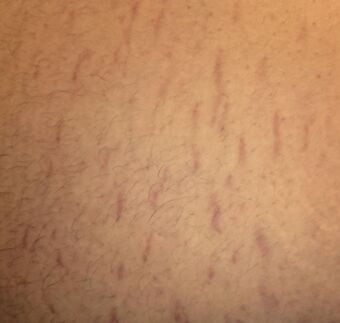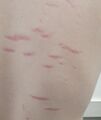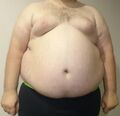Stretch marks
Topic: Medicine
 From HandWiki - Reading time: 8 min
From HandWiki - Reading time: 8 min
| Stretch marks | |
|---|---|
| Other names | stria, striae distensae |
 | |
| multiple recent (reddish) and a few older (white) stretch marks | |
| Specialty | Dermatology |
Stretch marks, also known as striae (/ˈstraɪiː/[1]) or striae distensae,[2] are a form of scarring on the skin with an off-color hue. Over time they may diminish, but will not disappear completely. Striae are caused by tearing of the dermis during periods of rapid growth of the body, such as during puberty or pregnancy, in which they usually form during the last trimester. Usually on the belly, these striae also commonly occur on the breasts, thighs, hips, lower back, and buttocks. Pregnancy-related striae are known as striae gravidarum.[3] Striae may also be influenced by the hormonal changes associated with puberty, pregnancy, bodybuilding, or hormone replacement therapy. There is no evidence that creams used during pregnancy prevent stretch marks.[4] Once they have formed there is no clearly effective treatment, though various methods have been attempted and studied.[5]
Signs and symptoms
Striae, or "stretch marks", begin as reddish or purple lesions, which can appear anywhere on the body, but are most likely to appear in places where larger amounts of fat are stored; the most common places are the abdomen (especially near the navel), breasts, upper arms, underarms, back, thighs (both inner and outer), hips, and buttocks. Over time, they tend to atrophy and lose pigmentation. The affected areas appear empty, and are soft to the touch.[6]
Stretch marks occur in the dermis, the resilient middle tissue layer that helps the skin retain its shape. No stretch marks will form as long as there is support within the dermis; stretching plays a role in where the marks occur and in what direction they run, however, there are a number of contributing factors (see: "Causes", below) to their formation.[citation needed]
They can (but do not always) cause a burning and itching sensation, as well as emotional distress. They pose no health risk in and of themselves, and do not compromise the body's ability to function normally and repair itself, however, they are often considered a cosmetic nuisance.[7] Young women are generally affected the most and often seek treatment for them from a dermatologist[8] and following pregnancy.[9]
Stretch marks from pregnancy >1 year postpartum
Causes
Stretch marks appear to be caused by stretching of the skin. This is especially true when there is an increase in cortisone[10] – an increase in cortisone levels can increase the probability or severity of stretch marks by reducing the skin's pliability. More specifically, it affects the dermis by preventing the fibroblasts from forming collagen and elastin fibers necessary to keep rapidly growing skin taut; this can create a lack of supportive material as the skin is stretched, and lead to dermal and epidermal tearing, which in turn can produce scarring in the form of stretch marks. This is particularly the case when there is new tissue growth (which can interfere with the underlying physical support of the dermis or epidermis, by displacing the supportive tissue).[citation needed]
Examples of cases where stretch marks are common, also given by the Mayo Clinic, include weight gain (in the form of fat and/or muscle), pregnancy, and adolescent growth spurts, though it is also noted that some medications, as well as other medical conditions and diseases, may increase the likelihood of stretch marks appearing. In the case of medication, the Clinic points to "corticosteroid creams, lotions and pills and chronic use of oral or systemic steroids" as a common contributing factor. Medical conditions that can contribute to stretch marks include Ehlers-Danlos syndrome, Cushing's syndrome, Marfan syndrome, and "adrenal gland diseases".[11][12][13]
Pregnancy
Pregnancy stretch marks, also known as striae gravidarum, are a specific form of scarring of the skin of the abdominal area due to rapid expansion of the uterus as well as sudden weight gain during pregnancy. About 90% of pregnant women are affected.[14]
A number of additional factors appear to promote the appearance of stretchmarks: one study of 324 women, done just after they had given birth, demonstrated that low maternal age, high body mass index, weight gain over 15 kg (33 pounds) and higher neonatal birth weight were independently correlated with the occurrence of striae. Teenagers were found to be at the highest risk of developing severe striae.[15]
These skin marks are symptoms of pregnancy caused by the tearing of the dermis, resulting in atrophy and loss of rete ridges.[16] These scars often appear as reddish or bluish streaks on the abdomen, and can also appear on the breasts and thighs. Some of these striae disappear with time, while others remain as permanent discolorations of the body.[7]
Mechanical distension and rapidly developing areas of the body during pregnancy (such as the abdomen, breasts, and thighs) are most commonly associated with striae formation. Some have suggested that relaxin and estrogen combined with higher levels of cortisol during pregnancy can cause an accumulation of mucopolysaccharides, which increases water absorption of connective tissue, making it prime for tearing under mechanical stress.[8][15] There also seems to be an association between higher body mass indices and in women with bigger babies and the incidence and severity of striae. Also, younger women seem to be at higher risk of developing striae during pregnancy.[8][17]
The prevalence and severity of striae gravidarum varies among populations. The current literature suggest that in the general population of the US, there is a 50%-90% prevalence of striae associated with pregnancy,[17] partly as a result of the normal hormonal changes of pregnancy and partly due to stretching of skin fibers.[4][18] Many women experience striae gravidarum during their first pregnancy. Nearly 45% percent of women develop striae gravidarum before 24 weeks of gestation.[7] Many women who develop lesions during the first pregnancy do not develop them during later pregnancies. Genetic factors such as genealogy and race also seem to be predictive in the appearance of striae.[19]
Prevention
Collagen and elastin are proteins in the skin that contribute to the skin's strength, resilience, flexibility, and help skin that has been stretched to recover its original state. Boosting the production of collagen and elastin helps prevent stretch marks from occurring.[20] Stretch marks can also derive from nutritional deficiencies. Consuming foods that contribute to the skin's health, such as zinc-rich foods, foods high in vitamin A, C, D, and protein rich foods, can help suppress stretch marks.[21] A systematic review has not found evidence that creams and oils are useful for preventing or reducing stretch marks in pregnancy.[4] The safety in pregnancy of one ingredient, Centella asiatica, has been questioned.[18] Evidence on treatments for reducing the appearance of the scars after pregnancy is limited.[18]
Treatment
There are no clearly useful treatments for stretch marks, although there are many different suggestions on how to remove them or lessen their appearance.[5]
Various efforts that have been tried including laser treatments, glycolic acid, and microdermabrasion.[22] Tretinoin (0.1% w/w), which is a retinoid, has found to be effective on early stretch marks in several studies. Hyaluronic acid also improves the appearance of stretch marks.[23][24] Topical tretinoin is categorized by the FDA as a known teratogen (causing malformations in fetuses) in animals, without adequate human studies on safety in pregnancy.[25]
Carboxytherapy is a known procedure; however, there is a lack of evidence to support how effective it is.[26]
Research into a new skin grafting technique called "microcolumn grafting / micrografting," that uses needles to take autologous full-thickness skin biopsies, is also being investigated as a potential treatment for stretch marks.[27][28]
History
Since ancient times, pregnant women have sought remedies to prevent stretch marks during pregnancy. Both ancient Ancient Greece and Romans used olive oil, while Ethiopians and Somalis used frankincense.[29]
Striae were first recognized by Roederer in 1773, and were later histologically described by Troisier and Ménétrier in 1889.[30] In 1936, Nardelli made the first morphologically correct descriptions.[31]
Terminology
Medical terminology for these kinds of markings includes striae atrophicae, vergetures, stria distensae, striae cutis distensae, lineae atrophicae, linea albicante, or simply striae.[citation needed]
References
- ↑ "striae - Wiktionary" (in en). 17 April 2021. https://en.wiktionary.org/wiki/striae.
- ↑ Dictionary of Obstetrics and Gynecology. Walter de Gruyter. 15 June 2011. pp. 230. ISBN 978-3-11-085727-6.
- ↑ "Are Pregnancy Stretch Marks Different?". American Pregnancy Association. 19 January 2013. http://americanpregnancy.org/your-pregnancy/are-pregnancy-stretchmarks-different/.
- ↑ 4.0 4.1 4.2 "Topical preparations for preventing stretch marks in pregnancy". The Cochrane Database of Systematic Reviews 2012 (11): CD000066. November 2012. doi:10.1002/14651858.CD000066.pub2. PMID 23152199.
- ↑ 5.0 5.1 "Interventions for the treatment of stretch marks: a systematic review". Cutis 94 (2): 66–72. August 2014. PMID 25184641.
- ↑ "Stretch Mark". Encyclopædia Britannica. http://www.britannica.com/EBchecked/topic/568975/stretch-mark. Retrieved 1 November 2009.
- ↑ 7.0 7.1 7.2 "Stretch Mark". http://www.mayoclinic.com/health/stretch-marks/DS01081k.
- ↑ 8.0 8.1 8.2 "Risk factors associated with striae gravidarum". Journal of the American Academy of Dermatology 51 (6): 881–885. December 2004. doi:10.1016/j.jaad.2004.05.030. PMID 15583577.
- ↑ Andrews' Diseases of the Skin: clinical Dermatology. Saunders Elsevier. 2006. ISBN 978-0-7216-2921-6.
- ↑ "Stretch marks - Symptoms and causes". http://www.mayoclinic.org/diseases-conditions/stretch-marks/basics/causes/con-20032624.
- ↑ "Skin". https://www.ehlers-danlos.org/what-is-eds/information-on-eds/skin/.
- ↑ "Cushing Disease". https://medlineplus.gov/genetics/condition/cushing-disease/.
- ↑ "Symptoms - Marfan syndrome". 3 October 2018. https://www.nhs.uk/conditions/marfan-syndrome/symptoms/.
- ↑ "Stretch marks during pregnancy: a review of topical prevention". The British Journal of Dermatology 172 (3): 606–615. March 2015. doi:10.1111/bjd.13426. PMID 25255817.
- ↑ 15.0 15.1 "Striae gravidarum in primiparae". The British Journal of Dermatology 155 (5): 965–969. November 2006. doi:10.1111/j.1365-2133.2006.07427.x. PMID 17034526.
- ↑ "Specific dermatoses of pregnancy: an evidence-based systematic review". American Journal of Obstetrics and Gynecology 188 (4): 1083–1092. April 2003. doi:10.1067/mob.2003.129. PMID 12712115.
- ↑ 17.0 17.1 "Clinical associations of striae gravidarum". Journal of Obstetrics and Gynaecology 24 (3): 270–271. April 2004. doi:10.1080/014436104101001660779. PMID 15203623.
- ↑ 18.0 18.1 18.2 "Common skin conditions during pregnancy". American Family Physician 75 (2): 211–218. January 2007. PMID 17263216.
- ↑ "Common skin conditions during pregnancy". American Family Physician 75 (2): 211–218. January 2007. PMID 17263216.
- ↑ "Skin: Layers, Structure and Function". https://my.clevelandclinic.org/health/articles/10978-skin.
- ↑ "Stretch Marks". https://my.clevelandclinic.org/health/articles/10785-stretch-marks.
- ↑ "Striae distensae: a comprehensive review and evidence-based evaluation of prophylaxis and treatment". The British Journal of Dermatology 170 (3): 527–547. March 2014. doi:10.1111/bjd.12681. PMID 24125059.
- ↑ "Striae Distensae Treatment Review and Update". Indian Dermatology Online Journal 10 (4): 380–395. 2019. doi:10.4103/idoj.IDOJ_336_18. PMID 31334056.
- ↑ "Stretch marks: Why they appear and how to get rid of them". 2019-11-11. https://www.aad.org/public/cosmetic/scars-stretch-marks/stretch-marks-why-appear.
- ↑ "Renova (tretinoin) cream". DailyMed. FDA and National Library of Medicine. http://dailymed.nlm.nih.gov/dailymed/lookup.cfm?setid=ad4cd608-ee26-4467-9957-a95b33101f9a.
- ↑ "Carboxytherapy And Mesotherapy Unproven" (Press release). 2009. Archived from the original on 13 May 2019. Retrieved 21 May 2016.
- ↑ "Use of autologous micrografting in the treatment of stretch marks". Dermatologic Therapy 33 (2): e13217. March 2020. doi:10.1111/dth.13217. PMID 31899571. https://www.researchgate.net/publication/338376116.
- ↑ "Reconstitution of full-thickness skin by microcolumn grafting". Journal of Tissue Engineering and Regenerative Medicine 11 (10): 2796–2805. October 2017. doi:10.1002/term.2174. PMID 27296503.
- ↑ "Botany". http://www.botanical.com/botanical/mgmh/f/franki31.html.
- ↑ "CO2 Laser for Stretch Marks.". Clinical Approaches and Procedures in Cosmetic Dermatology. Cham: Springer International Publishing. 2017. pp. 1–10. doi:10.1007/978-3-319-20251-8_12-1. ISBN 978-3-319-20250-1.
- ↑ "Striae distensae (stretch marks) and different modalities of therapy: an update". Dermatologic Surgery (Ovid Technologies (Wolters Kluwer Health)) 35 (4): 563–573. April 2009. doi:10.1111/j.1524-4725.2009.01094.x. PMID 19400881.
External links
| Classification | |
|---|---|
| External resources |
 |
 KSF
KSF




